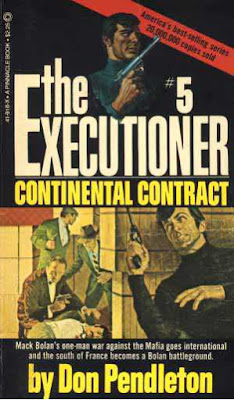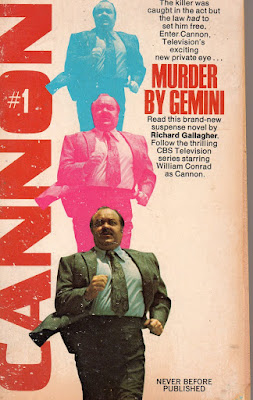
Shout Factory's most recent Roger Corman's Cult Classics DVD set is its first Lethal Ladies Collection. Corman's New World Studios was a bit ahead of its time when it came to featuring butt-kicking women in leading roles. Very rarely did you see female action heroes on the big screen during the 1970s except for Asian martial arts films (often featuring Sue Shiomi or Angela Mao) and Roger Corman productions.
Most of the Corman films play quite contradictory, in that, yes, their women were frequently empowered and had the last laugh against their opponents, but not after they had been abused and/or unclothed first. Corman may have been a feminist (and I think his unequaled-in-Hollywood record of hiring women directors, editors, screenwriters, etc. proves he was), but he was also a capitalist, and he knew it was important for ticket sales to film his leading ladies in the nude at the same time (sometimes literally the same time) they were kicking men's asses.

1975's TNT JACKSON is an obvious attempt to rip off AIP’s Pam Grier movies like COFFY and FOXY BROWN. This abysmal blaxploitation number shot in Manila stars gorgeous PLAYBOY model Jeanne Bell as Diana “TNT” Jackson (“A one-mama massacre squad!”), a Harlem ex-con who goes to Hong Kong to find her missing brother. Hell, she’s just off the plane when she’s attacked by a bunch o’ dudes waving knives.
Of course, she kicks their asses (in one of the most inept kung fu battles ever filmed) just in time to bump into Elaine (SUMMER SCHOOL TEACHERS’ Pat Anderson), the sexy moll of mobster Sid (Ken Metcalfe, also the stunt coordinator and co-writer with character actor Dick Miller). TNT goes undercover as a prostitute to discover her new man, drug dealer Charlie (Stan Shaw, later in RUNAWAY), is the guy who murdered her brother. Time to team up with a wacky brothel owner (Chiquito) to wipe out Charlie, Sid, and Sid’s entire organization!
Sloppily directed by the prolific Cirio H. Santiago (VAMPIRE HOOKERS), TNT JACKSON is not very good, but often wildly hilarious. Its most notorious scene finds Bell in a wild karate fight clad only in black panties (or sometimes white, thanks to a glaring continuity error). Executive producer Corman loved the topless karate so much, he recycled it in FIRECRACKER (we'll get to this), ANGELFIST (with silicone-enhanced Cat Sassoon), and ANGEL OF DESTRUCTION (Maria Ford).
Bell (THE MUTHERS) is beautiful, but is neither a fighter nor an actress, reciting her dialogue with all the fervor of someone ordering a McRib in the drive-thru lane at McDonalds. Cinematography, editing, and music (swiped from other Corman flicks) are subpar. Even though barely five minutes go by without a kung fu battle breaking out, the action scenes are less than believable.
But you know what? Sometimes, terrible kung fu is just as entertaining as awesome kung fu. TNT JACKSON is a bad movie, but it’s short at 71 minutes and not dull. Jeanne Bell is nice to look at, the guy doubling her is funny to look at, and the over-the-top kill of the final villain will leave you with a hearty guffaw.

FIRECRACKER, released in 1981, is easily the best and most entertaining film in the set. Corman asked director Cirio Santiago to remake TNT JACKSON in Manila with blond Jillian Kesner (RAW FORCE) stepping in for Jeanne Bell. After Santiago was through, Corman decided it needed more gore and nudity, so he hired Allan Holzman (FORBIDDEN WORLD) to direct two new nude scenes in Los Angeles. One of them, a redo of Bell’s infamous topless kung fu fight in TNT JACKSON, is easily the best part of FIRECRACKER.
Suzanne Carter (Kesner) flies to Manila to investigate the disappearance of her journalist sister and learns local mobster Erik (Ken Metcalfe again) may be responsible. Suzanne becomes romantically involved with Chuck (Darby Hinton of HI-RIDERS fame), Erik’s right-hand man, who recruits fighters to perform in his boss’ “arena of death!”
Unsurprisingly, Suzanne will eventually find herself battling for her life there by picture’s end, but not before her classic topless fight, which begins when she’s jumped on the street after dark by two men who systematically strip her to her panties between karate kicks and chops.
Like TNT JACKSON, the uncredited music score is pilfered from other Corman productions, most notably (and obviously) Mark Lindsay’s driving synth from SHOGUN ASSASSIN. The arena of death is the same location used by Cannon for the climax of ENTER THE NINJA, and I would bet the lumber yard where Kesner’s topless fight takes place was shot on the Venice lumber yard where Corman built his New World studios.
Of course, the film is completely derivative, but it’s at least as watchable as TNT JACKSON. It has the same plot and an equally hilarious gore ending, but Kesner is a more talented star than Jeanne Bell, and FIRECRACKER is too short (77 minutes) and action-packed to be boring.

Even compared to the sloppy TNT JACKSON and FIRECRACKER, 1977's TOO HOT TO HANDLE is a real bore and not worth your time. Blond star
Cheri Caffaro had built a small following based on three tawdry action pictures in which she starred as a promiscuous spy named Ginger. Directed by Don Schain (Caffaro’s husband) and produced by Ralph Desiderio, the so-called “Ginger Trilogy”—GINGER, THE ABDUCTORS, and GIRLS ARE FOR LOVING—were lurid, clumsy adventures that pushed the limits in terms of on-screen nudity and sex without crossing over into hardcore territory. Caffaro was supposedly 26 when GINGER came out in 1971, but looked ten years older, and her well-worn sexual demeanor came across as more grimy than erotic.
Backed by New World, Schain and Desiderio brought Caffaro to the Philippines for this turgid action movie that would turn out to be the actress’ swan song. She plays a seductive contract killer named Samantha Fox, but, for all intents and purposes, she’s basically doing Ginger again. The violence is remarkably tame for a Corman release, though Schain does stage a slow-motion cockfight, during which Samantha fantasizes about being naked!
After suffocating a kinky businessman (“special guest star” John van Dreelan) in his torture room during S&M, Samantha receives a new assignment. At van Dreelan’s funeral, Miss Chow (Grace Lee) offers Samantha $150,000 to bump off three gangsters living in Manila. Researching her marks allows her to exercise her skills as a mistress of disguise, which include making herself up in brownface to portray a Filipino maid!
Caffaro designed her own wardrobe for TOO HOT TO HANDLE, and her clothes are as ridiculous as the logy fight scenes, which look as though Schain filmed the half-speed walkthroughs. Considering the screenplay was written by Jan Michael Sherman and Don Buday, who also penned the campy KISS MEETS THE PHANTOM OF THE PARK, it’s no surprise how dumb it is, though some care is taken to flesh out the relationship between Sanchez (Vic Diaz) and Domingo (Aharon Ipale), the two Manila cops investigating the murders.
Originally set up at Avco Embassy as HIT WOMAN, Schain’s final film as a director (five of his six movies starred Caffaro) went into production in January 1976 and was released by New World to (deservedly) little box office over a year later. Although his wife retired from acting, Schain remained in the industry as a producer, his biggest hits being the lucrative HIGH SCHOOL MUSICAL franchise of the late 2000s.
More interesting than TOO HOT TO HANDLE is Cheri Caffaro's audio commentary. It should be considered something of a coup for Shout Factory, since Caffaro more or less dropped out of sight after the 1970s and doesn't seem to have been interviewed since. She seems like a nice lady and talks about TOO HOT TO HANDLE and her other films with good humor. It doesn't go into as much detail as I would have liked, but it's still an important artifact for trash-film historians.
Caffaro also donated some stills for use in the DVD's Stills Gallery. Shout Factory rounds out the two-disc set with a handful of trailers. Unfortunately, both DVDs contain the same trailers, among them FIRECRACKER, THE BIG DOLL HOUSE, and JACKSON COUNTY JAIL.
Skip TOO HOT TO HANDLE, but for a good price, the Lethal Ladies Collection is worth picking up for FIRECRACKER and TNT JACKSON. Neither is particularly good, but they're great, brisk fun.
 If HAWK is remembered today, it's as the first television series to star Burt Reynolds in the leading role. Although Reynolds had been a regular on RIVERBOAT and GUNSMOKE, he did so as the sidekick to leading men Darren McGavin and James Arness, respectively. In 1966, series creator Allan Sloane (later an Emmy winner for writing TO ALL MY FRIENDS ON SHORE) cast Burt as John Hawk, a tough New York City cop with a twist: he was also a full-blooded Iroquois.
If HAWK is remembered today, it's as the first television series to star Burt Reynolds in the leading role. Although Reynolds had been a regular on RIVERBOAT and GUNSMOKE, he did so as the sidekick to leading men Darren McGavin and James Arness, respectively. In 1966, series creator Allan Sloane (later an Emmy winner for writing TO ALL MY FRIENDS ON SHORE) cast Burt as John Hawk, a tough New York City cop with a twist: he was also a full-blooded Iroquois.




















